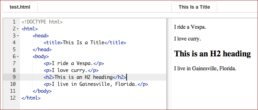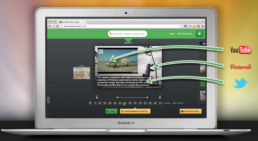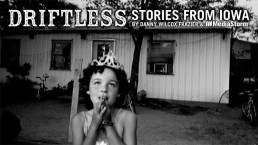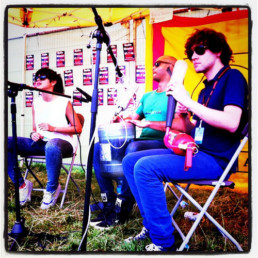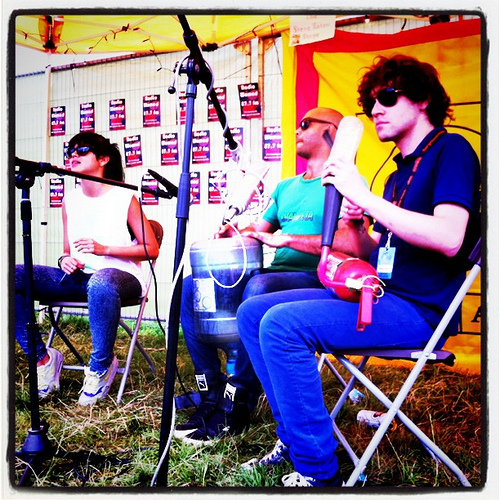Journalism Tech Review: FiRE
NOTE: Fire 2 is no longer being updated. Smartphones now have much more sophisticated recording apps inbuilt.
Many apps have been developed to enhance smartphones’ often impressive audio recording ability but FiRe was the first to really attempt to be a professional field recorder. Initially launched on the iPhone (at a pretty high price of £3.99) it did prove to be very reliable so much so that many commercial radio stations (including GMG) encouraged reporters to use it instead of a bulky Marantz. Last year Audiofile stopped supporting FiRe and instead offered FiRe 2 an upgrade of the recorder which required you (somewhat cheekily) to buy it for another £3.99.
How it helps you
Although there are plenty of apps on the market that are easier to use this one is not only professional but also extremely flexible. You can add your own metadata which prevents the audio getting lost and can help when adding further context to an online story. With FiRe 2 there is integration with Dropbox - blowing Dropvox out of the water by a considerable distance. A sub or producer could easier pick up a story and it is easier to configure than FTP. There are also some pretty nifty editing tools so you’re out in the field getting an interview anyway you can easily file the audio before the story. And there's Soundcloud integration which in private could be a handy archive but in public could also mean that a story could be broken on the platform.
In Practice
To test this app thoroughly, I recorded an interview using a the new app, we recorded it onto the camera microphone in an echoey dressing room whilst the interviewee ate a satsuma. The sound wave monitoring is very accurate which means you can avoid distortion. The noise quality has always been good but there’s a few more EQ settings (powered by Izotope) and extended metadata you can add before downloading. I did try editing the audio using the app but it was very fiddly, and then it crashed. I trimmed the audio (particularly the satusuma sucks) using Audacity on my computer and then uploaded to Audioboo, you get space for unlimited Boo’s on Audioboo whereas I’ve already filled my free Soundcloud account.
Drawbacks
You don’t need to have FiRe 1 installed to use FiRe 2 but, somewhat irritatingly it doesn’t incorporate the recordings you have already on the phone. There are a lot file format options on the new app but it does seem buggier than the first version.
Summary
An excellent field recorder - an average exporter - a pretty rough editor.
Rating
Journalism Tech Review: IFTTT
If This Then That (IFTTT) launched in September 2011 promising to be the “gaffer tape that holds the internet together”. This means various social media, cloud archives and even physical internet enabled products (a full list of channels here) can be connected together with simple instructions and without learning code.
In practice
Automated online activity which would require you to wrangle with the unwieldy Yahoo Pipes or the intimidating Mac Automator, is given a user-friendly interface. You can also share your favourite ‘recipes’ and allow people to use them. I use them a lot to allow for a more organic duplication of social media. For example, every image that I 'favourite' on Instagram automatically drops into Tumblr (under the Instagram tag) or when a new photo is uploaded by me to Flickr it also uploads them to a gallery on my Facebook page. Pictures are the currency of these social media channels and spreading them across platforms increases their exposure and engagement.
How it helps you
The reason I decided to post about this web application is because of the announcement last week Google is to discontinue its RSS Reader service after July 2013. Since I’ve been experimenting with Feedly as a replacement and implementing a process that doesn't leave me relying too heavily on a single provider. News stories that I like are saved to Pocket from within Feedly and then from Pocket they’re piped with IFTTT to my Delicious and Pinboard bookmarks. This way I can organise my favourite stories and primary sources without depending on one web service. There are other recipes that could help your working life such as this which (once it allows for UK calls) would let you to effectively dial in a short story. If you were sending back photos or videos from a mobile phone you could speed publish across multiple platforms or notify a desk editor automatically. You can also sync certain documents with Google Drive or even use Google Drive to collect data on a single spreadsheet which might be useful for Data Journalism.
Drawbacks
Although there are 60 active channels on IFTTT with 433,065 tasks created by users in its first year it can be frustrating when you realise that your new app is not included. Particularly disappointing for me is Google Plus’s refusal to let people automate its updates (pages or personal) or Twitter’s restriction of their API. This platform really depends on an open internet.
Summary
A simple way of controlling your web and mobile activity.
Rating
![]()
![]()
![]()
![]()
![]()
Journalism Tech Review: Learn CSS Layout
History
Many of you who have worked with web content management systems or your own personal blog will have a basic understanding of HTML. Just by clicking on the HTML tab or by holding down CTRL+U you can get a grasp of what is going on behind any web page. But CSS can be a mystery as it is rarely placed within HTML (called inline). CSS stands for “Cascading Style Sheet” so instructions should be entered into a separate page within a website’s directory. As Online Journalist Mindy McAdams points out the excellent web-based coding guide Codeacademy often loses people at inline. This online tutorial takes about 20 minutes to run through and very simply explains the fundamentals of CSS.
In practice
I used what I’d learnt to completely change the overall look of a Tumblr website, also to stop to the Footer shooting up to the middle of the page when viewing this website in Internet Explorer.
How it helps you
If you use any website to collect together your stories, build feature ideas or grow an online audience, then knowing the fundamentals of CSS means you can customise your site to appear more professional. A basic understanding of HTML and CSS is needed if you want to scrape any kind of website, as Classes are often used to mark-up useful information and (as explained in The Data Journalism Handbook) can help convert a web page into a usable spreadsheet format.
Drawbacks
I would have liked more opportunity to try out the code. When you try and apply the CSS there is a missing link which has to be pieced together by reading this tutorial. I realised I needed to select the class by writing and using the correct "selector". As with many of these tutorials, it’s going to slip straight out of your head if you don’t apply it a few times.
Summary
An easy to follow tutorial, which needs further joining up for application.
Rating
![]()
![]()
![]()
![]()
![]()
Journalism Tech Review: Tweetbot
History
Tweetbot took advantage of Twitter’s relatively open API to develop an iPhone native app which easily outshone their basic mobile offering. Although Twitter significantly upped its game with a redesign last year (following the acquisition of Tweetie and its coder), Tweetbot broke free from some of Twitter’s more idealistic attributes - including the patronising and advertising heavy #discover option.
In practice
You can very easily flick between multiple accounts, lists and searches. Particularly useful is Tweetbot’s “gestures” - a simple swipe and you can view replies or conversations on any tweet. Tap once to view a link, hold down to use the link or save to any number of apps, or configure triple tap options for yourself.
How it helps you
For feeding back tweets and multimedia on the move it is very good, especially with the facility to upload in the background. Also, not only can you flick between multiple Twitter personalities (for example public and private you) but you can keep track of Twitter lists. You can even turn a Twitter list into your timeline of contacts’ tweets or monitor keep on top of a story by monitoring a hashtag.
Drawbacks
Although it can be always on you have to drag down to refresh your timeline. If you want to keep abreast of several areas you have to swipe around. Tweetbot only has column based filtering and searching in the iPad app. Both iOS apps come with a £1.99 price tag. And beware, if you like it and want to start using it on your Mac then it’ll cost you £13.99 – apparently raised by Tweetbot to discourage too many users after Twitter restricted its API. Perhaps because of this, we’re unlikely to see anything developed for Android or PC anytime soon.
Summary
A neat, fast and easy way to keep on top of Twitter on your iPhone.
Rating
![]()
![]()
![]()
![]()
![]()
Journalism Tech Review: Cowbird
History
Cowbird launched on December 8, 2011 and immediately became a place for people from the Occupy Wall Street movement to share their stories. Last year National Geographic used the website to help residents from Pine Ridge Indian Reservation to tell their stories. It's easy to see why it would appeal to National Geographic as it allows you to tell stories with strong images. A few weeks ago it was announced there is now an embed option, allowing you to place your stories on most websites.
In practice
I uploaded a photo and told a small story. Cowbird has a freemium model so one image is the maximum you can upload without paying $60 to become a "citizen". Other advantages of being a citizen is the ability to link stories and further customise your stories such as adding your own handwriting, adding hyperlinks, changing the colour palate and further interacting with the community. But there's nothing to stop you putting different stories in parallel in one post, but if you wanted to use the platform to collect other people's stories around a subject then you'd have to pay. Although the embed (below) is nice, on Cowbird the story fills the screen and has a stronger impact.
The share (or "retelling") facilities are pretty easy for Facebook, Pinterest and Tumblr. Although, as with many inbuilt auto post functions they don't embed natively to their platform or tag properly. I found it nicer to just use the embed function on my Tumblr page for example.
How it helps you
The stories that you can create are best accompanied by strong photo stories. You can also embed audio so there's nothing to stop you from telling media-rich stories. If you do decide to opt for citizenship then this could all be built into the platform and the multipage option would allow you to tell longer stories, even comic strips or data stories.
Drawbacks
All the best functions come at a price. The embed function is good but the mobile interface is less appealing. Although this is probably not the central aim of this site, it would be difficult to collate a breaking news story, as this requires citizenship.
Summary
An intriguing way to tell multimedia stories without learning any HTML.
Rating
![]()
![]()
![]()
![]()
![]()
Journalism Tech Review: Soo Meta
NOTE: Sooo Meta is sooo over.
History
Soo Meta is a browser based editing tool which according to the website blurb allows you to create multimedia stories in minutes.
How it helps you
As well as marketers and educators, this tool was created with journalists in mind "Viewers expect more and more visual content. It’s time to deliver short movies, rich-media stories in your posts! Your audience will love it!" Like with Popcorn Maker the idea is that you enrich your original media by adding more multimedia frills. The video demonstrates how to use the Google bookmarklet to collect words, video and images from around the web, this has the added advantage of allowing you to cite your sources.
In practice
It took longer than "a few minutes" to get to grips with this tool. This is because the demonstration video only shows how to grab material via the bookmarklet, yet it doesn't show you how to install the bookmarklet. Once I'd worked that out I was well into my story. When I attempt to install in Chrome it crashed, I finally installed it in Firefox but was unable to view the video in this browser. I had to complete the edit in Chrome then add the images again (so it carried across the metadata) in Firefox. More than once whilst hopping about I crashed my browser and had to step back.
Drawbacks
Aside from the browser malfunctions, there's very little support for this tool and you are pretty much on your own when it comes to working out what's wrong. Even more unhelpfully if you do try and Google "Soo cut" (the name of the bookmarklet) you get a load of "soo cute" images and chintzy Google apps.
Summary
A great idea which appears simple but can be frustratingly tricky in practice.
Rating
![]()
![]()
![]()
![]()
![]()
Journalism Tech Review: ipadio
Originally posted on the Newsroom 360 website, I've decided to post the series on my blog starting with the most recent first. NOTE since I published this series on the website many of the apps and software have been degraded and closed. I'm living them on my site for posterity.
History
The fact that this app's name is pronounced I-pay-dio gives some clue to its origins. Long before the iPad was even a glint in Steve Jobs' retina this tool was originally created to host IP Radio, making it easy for people to broadcast from their mobile phone. Instead of just being designed for the slick multimedia prowess of the iPhone, ipadio was way more utilitarian, enabling people to be able to broadcast on many mobile phones with a reception of 2G or less, and even from satellite phones. At news:rewired they announced the launch of an iOS app which like its Android equivalent also has the ability to livecast across a broad spectrum of social media channels.
How it helps you
According to ipadio's CEO Dr Mark K Smith there are over 200 uses for ipadio but there are plenty of features useful for journalists. It's particularly good for live news stories because of its efficiency in low bandwidth areas. The fact that you're able to phone in your report also means it can get past internet restricted events, which is why it was used during the Egyptian revolution and is currently being used by someone climbing Everest. It also has a mapping function which makes it perfect for travel journalism or filing back reports from a march. Journalism.co.uk have also shown how this phone call function can be used as a conference call to record an interview - which is partially transcribed via Spinvox.
In practice
I installed the new iPhone app onto my phone and did a quick quiet test. The system is straightforward to use and you can attach up to four pictures before uploading.
I also uploaded an old John Paul Jones interview with pictures or "Phlog" to the site. This offered more customisation including the ability to add tags and alter the location.
After I'd done this Dr Smith (CEO) got in touch with me in person and said he liked the John Paul Jones interview and allowed me to video stream on my phone. I tested out this function with a video that was broadcast and also uploaded to YouTube almost instantly.
Although this ipadio video Flash embed (which is still in Beta) disturbs my the HTML on this page.
Finally, I tested the audio from both the iPhone recording function:
And by phoning my broadcast in:
As expected, the phone-in audio was more condensed than iPhone but both uploaded very quickly, with the latter actually beating the former despite having to run through Spinvox's transcription.
Further conversations with the very helpful Dr Smith led me to discover the Beta Admin function which allows you to fully customise the privacy settings of each broadcast. This means you can keep your phone interviews private but can still report "as live" if need be. I was very impressed by the support community around this app including the blog and training videos.
Drawbacks
Only a few minor gripes, I'd say that the audio quality is not as good as Audioboo and that the video doesn't allow you to add metadata on-the-hoof as Bambuser does.
Summary
A great tool for filing multimedia stories from the field no matter what device you're on.
Rating
![]()
![]()
![]()
![]()
![]()
Insight into Brian Storm's MediaStorm
This week at Newsroom360 we were visited by Brian Storm.
Storm cut his teeth in MSNBC and Corbis before starting his own production company. MediaStorm works with journalists for a variety of news organisations, NGO's and charities. Its style is longer form, non-perishable, universal stories with high production values. Although the films have beginnings in beautifully composed photo-journalism it's the interplay between this and well rendered video composition which really give the stories an emotional impact and feeling of quality. Storm showed us "Harry and Helen" from Driftless as an example of this.
Borrowing from Hollywood
MediaStorm's films take conventions from cinema rather than a vérité news style, using atmospheric music and dropped introductions to heighten dramatic impact and put people at the centre of the story. Even the way that his videos are marketed using teasers or "preludes" which resemble Hollywood trailers.
Revenue Models
These promos are often used to raise funds through the Kickstarter crowd-funding site. For A Darkness Visible, $10,000 was raised privately in return for limited edition rewards. Even when making work for with clients Brian depends on his work's virality, allowing sharing on social media and embedding for dedicated blogs helps build momentum. Book-ending this content with adverts is a significant revenue driver, although Storm concedes that CPM (cost for thousand impressions) for adverts in the US is higher than here. Interestingly longer stories retain the viewer if the film is interesting enough, Storm gave his own sites stats as an example: the average time on site is 16 minutes. Storm also recommended treading carefully and choosing advertisers and other streams such as sponsorship affiliation should also be explored.
Slow vs Fast
Brian's message is you can be two things with online video: funny or quality. Journalists tend to be better at the latter. We have to consider how longer-tail in-depth production fits into the daily or weekly news cycle. Although, as a passing shot Storm also shared a three team collaboration of writer, photographer and film maker who managed to turn around a stirring documentary in a week.
Radio Womad gets Mashed
Continuing my experiments with mobile journalism, this weekend I embedded myself at Womad Festival with the onsite radio team.
I used last year's project with Shambala as a template for my activity. The live blog in particular carried through similar elements, including a mobile friendly blog and distribution techniques - but there were differences, as I'll explain.
Wi-fi Network
Uploading material on a 3G network was a real problem at Shambala, and as I've mentioned before this made mobile journalism at last year's festival very tricky. Thankfully this was not an issue at Womad, which was down to the excellent site wide public WiFi provided by Etherlive. I spoke to the MD Chris Green and he told me in total they shifted 1TB (terabyte) of internet traffic this weekend - which I got really excited about, my wife didn't.
Kit and Tech
Last year I had an Android HTC Tattoo, Flips, dictaphones, SLRs and a Flash mic. 2011, I had an iPhone 4. My dependency on additional bits of tech to give comprehensive multimedia coverage was less needed. It also meant that I approached it differently. Video was shot and uploaded directly to YouTube from my phone and photos were initially shared on Instagram first. I still had my SLR but Instagram tended to be my first port of call. I would like to find a web app that makes it more useable and interactive online - not least an app that allows search and the opportunity to search for tagged photos and install slideshows. Further investigation is needed into the Instagram Realtime API and these interfaces. At Womad Festival, all my photos were run through Flickr with video and slideshows broadcast on YouTube.
Radio Womad
Being involved with the Radio Womad staff meant audio was a priority, features and "Secret Sessions" (essentially backstage acoustic performances), were broadcast on the radio and enhanced for the internet. Unfortunately a big question mark still hangs over whether we have the right to publish this material. I hope we can as the Secret Sessions were fantastic - particularly the session with Bomba Estereo whose improvised instruments included a fire extinguisher and a water bottle.
Radio Womad's backstage gazebo was a perfect platform to let the artists do what they want in their way and I'm delighted there's a digital archive of this ready to be shared with a global audience. I think it would be great for Radio Womad to have a shareable archive of the sessions.
Whilst the video was by no means professional it would offer music fans a glimpse into the unique, unplugged gigs. Also many of the labels and artists liaisons want to see the material so it seems a shame not to share with the wider public. Surely sharing this material would be good for everyone?
Staff
My experience with Shambala was essentially to manage a team who in turn managed our Press Gang (teenagers we trained to capture footage on our behalf). For Radio Womad it was about adding value, enhancing social media and putting a multimedia twist on the audio material. Although the Radio Womad team were largely impressed by what I achieved it was difficult to wrangle multimedia stuff (which they were taking personally) off them, in the end I managed to steal memory cards and copy clips from the station server to create my material.
The benefit of the team at Shambala is that we saw the festival through younger eyes. I'd love to work with Radio Womad again but I wonder whether next time the project might benefit from repositioning itself with the main website, which could also help sidestep any reproduction permission issues.
Moving on
Whilst for the moment the secret sessions may remain secret it seems to me that this is a direction that I'd been thinking about with Village Underground "In The Cab" performances. I know recording and sharing the performance of the artist Marques Toliver secured him several UK gigs because the material was so shareable and exposure extended beyond the 300 people who turned up to see him live. This is an area which I will no-doubt return to when I undertake some more work with Village Underground later this month. As for the festival itself and working with Radio Womad, it was a hugely enjoyable experience and I would love the opportunity to do something next year.
I've collected everything together at the working blog, Facebook, and have hosted all material on the Mashed Festivals Soundcloud Flickr and YouTube Channels.
I would love to know what you think - or if you're interested in working with Mashed Festivals.
Interview: GMG Radio working on a ‘hybrid’ digital future for radio
The digital revolution raging through traditional media is accelerating and radio is no different: there are growing numbers of digital and internet listeners, meaning that the business model and consumption trends are changing fast. Yes, people mostly listen via AM/FM and the stations sell advertising (or get publicly funded via the BBC) but the next few years are crucial.
As James Cridland points out, the combined audience of the Radioplayer online radio platform in the UK is 5.7 unique users a month, with more than 22 million individual sessions, a bigger audience than ITV and Channel 4 combined.
And the possibilities are huge: according to RAJAR, radio listening reached its highest level ever recorded (91.6 percent of the UK population) in the first quarter of this year.
But the BBC still looms large with an audience including more than 55 percent of the UK adult population, making the job of commercial radio brands – facing the threat of platform shift and the BBC – a tough one indeed.
One man charged with understanding all that is James Rea, who was last month appointed Guardian Media Group’s deputy group programme director. He still retains responsibility for for news output and special broadcasts, but with a lot more besides, including “developing new partnerships in the digital arena to extend the group’s content to new audiences,” according to the company.
According to figures from last October, one in four listeners of GMG stations (which comprises Rock, Real and Smooth radio) audience are tuning-in via a digital/online platform. I caught up with Rea to ask him what the plans are…


